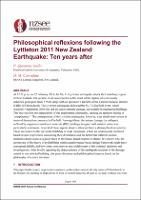| dc.description.abstract | At 12:51 p. m. on 22 February 2011, the Mw 6.3 Lyttelton earthquake struck the Canterbury region of New Zealand. The seismic event was reported as the result of the rupture of a previously unknown geological fault, 5.9 km deep, with an epicentre 6 km SSE of the Central Business District (CBD) of Christchurch. The Lyttelton earthquake followed the Mw 7.1 Darfield event, which occurred 4 September 2010, but did not cause extreme damage, particularly in engineered buildings. This fact satisfied the expectations of the engineering community, creating an apparent feeling of ‘complacency’. The consequences of the Lyttelton earthquake, however, were much more severe in terms of destruction compared to Darfield. Amongst these, the intense damage (or collapse) suffered by engineered reinforced concrete (RC) buildings designed with modern codes was particularly worrisome. Several of these aspects deserve attention from a philosophical perspective. These are related to the inevitable fallibility of code provisions, which are continuously modified based on new experiences uncovering their downsides; and the belief that different seismic demands cannot occur at a given place in the future, based on prior evidence. It is shown why the current use of the theory of probabilities within a performance-based design framework might have conceptual pitfalls, and how ethics constitute an unavoidable part of the technical decisions and investigations. After briefly reporting the characteristics of the earthquake and part of the damage caused to one selected building, this paper discusses such philosophical aspects, based on the philosophy of science literature. | |

